Teaching and Learning Report: Customer Service Training Analysis
VerifiedAdded on 2022/09/22
|18
|4815
|73
Report
AI Summary
This report analyzes various aspects of teaching and learning, including professionalism, dual professionalism, and the influence of professional values on customer service teaching. It explores how social, political, and economic factors shape educational policies and examines the role of organizational policies, codes of practice, and guidelines. The report further investigates the roles of stakeholders and external bodies in education and training, emphasizing accountability and the importance of partnerships with employers and other stakeholders. Finally, it assesses the impact of current educational policies on customer service teaching, the effects of accountability on curriculum design, delivery, and assessment, and the influence of organizational requirements and expectations on curriculum and practice.
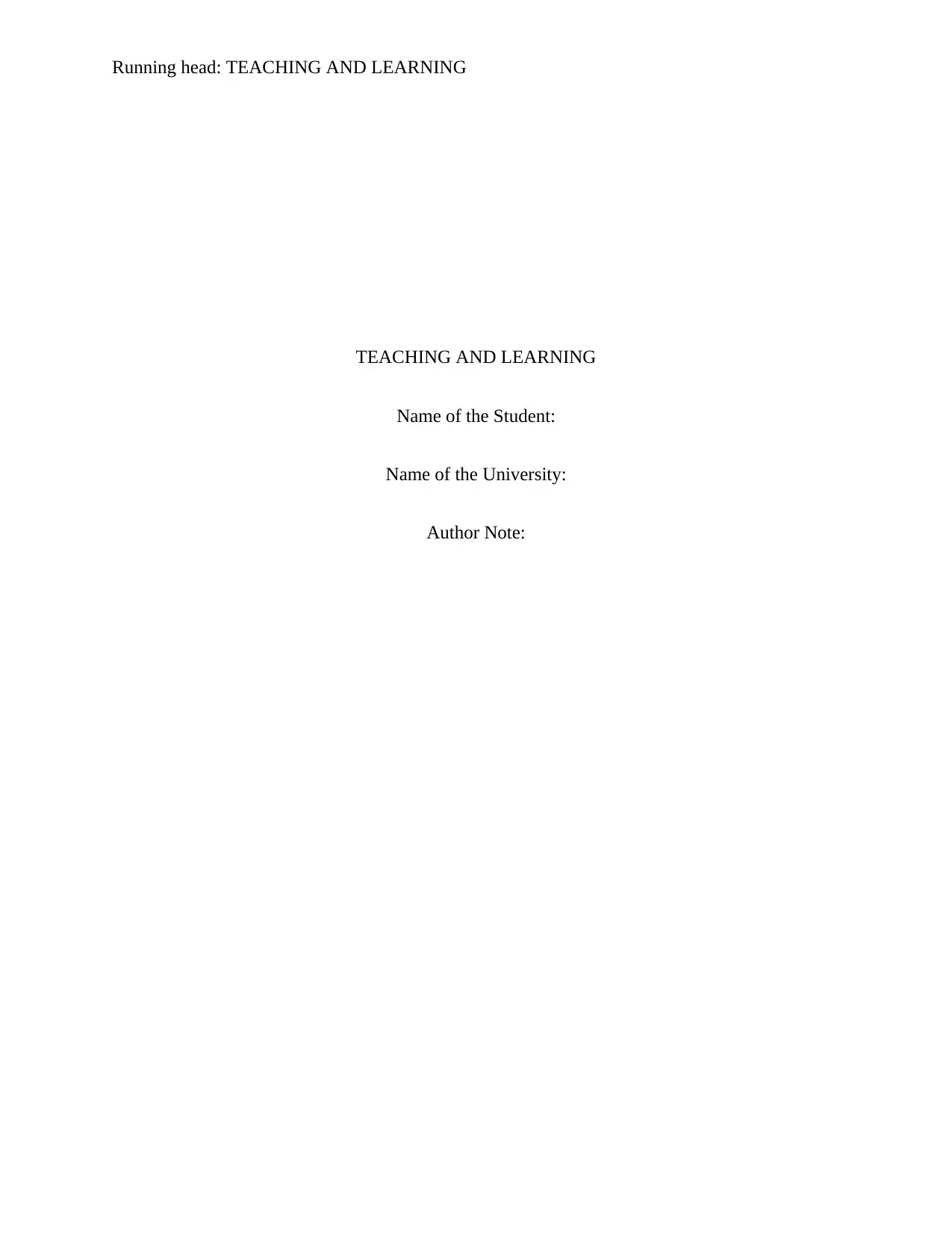
Running head: TEACHING AND LEARNING
TEACHING AND LEARNING
Name of the Student:
Name of the University:
Author Note:
TEACHING AND LEARNING
Name of the Student:
Name of the University:
Author Note:
Paraphrase This Document
Need a fresh take? Get an instant paraphrase of this document with our AI Paraphraser
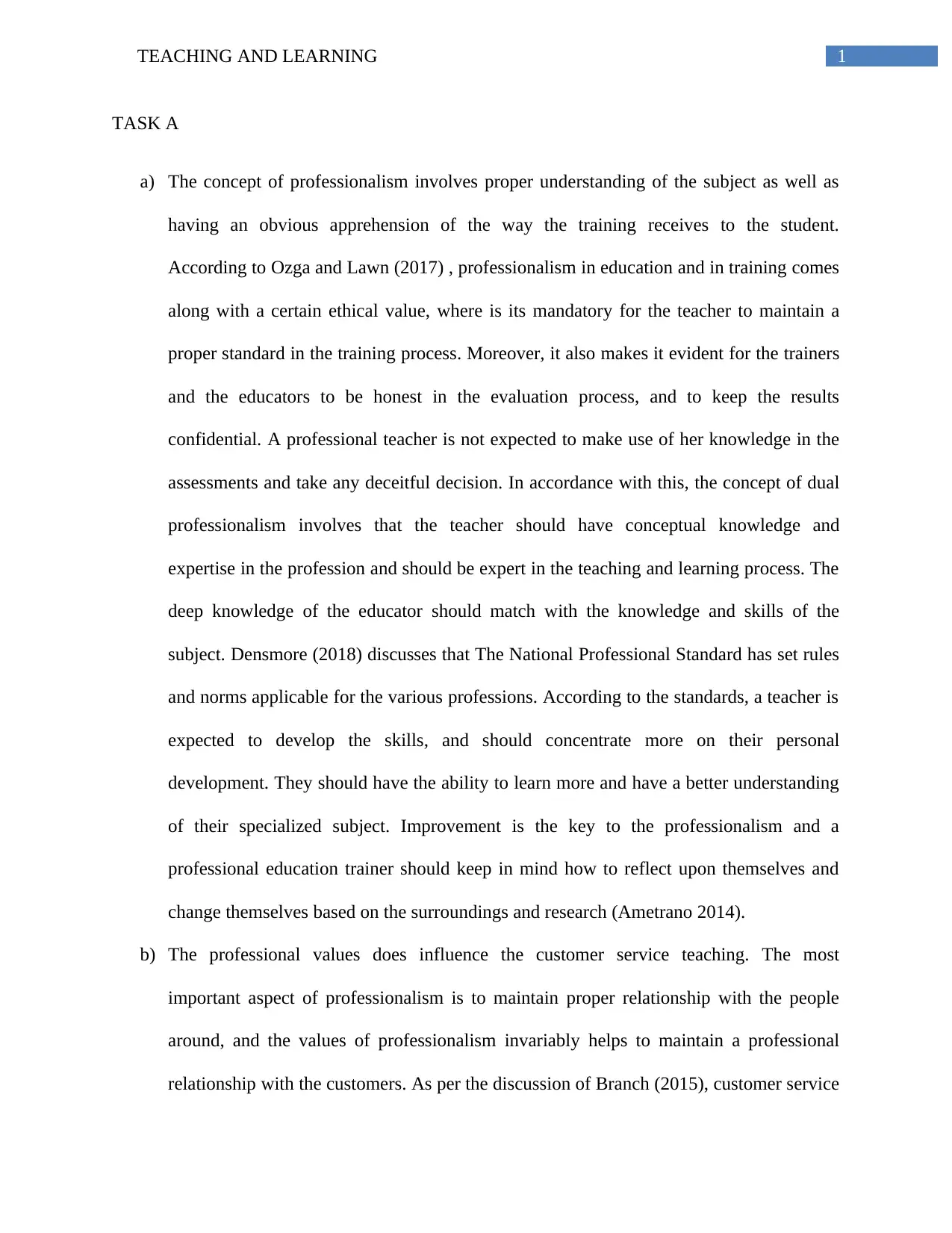
1TEACHING AND LEARNING
TASK A
a) The concept of professionalism involves proper understanding of the subject as well as
having an obvious apprehension of the way the training receives to the student.
According to Ozga and Lawn (2017) , professionalism in education and in training comes
along with a certain ethical value, where is its mandatory for the teacher to maintain a
proper standard in the training process. Moreover, it also makes it evident for the trainers
and the educators to be honest in the evaluation process, and to keep the results
confidential. A professional teacher is not expected to make use of her knowledge in the
assessments and take any deceitful decision. In accordance with this, the concept of dual
professionalism involves that the teacher should have conceptual knowledge and
expertise in the profession and should be expert in the teaching and learning process. The
deep knowledge of the educator should match with the knowledge and skills of the
subject. Densmore (2018) discusses that The National Professional Standard has set rules
and norms applicable for the various professions. According to the standards, a teacher is
expected to develop the skills, and should concentrate more on their personal
development. They should have the ability to learn more and have a better understanding
of their specialized subject. Improvement is the key to the professionalism and a
professional education trainer should keep in mind how to reflect upon themselves and
change themselves based on the surroundings and research (Ametrano 2014).
b) The professional values does influence the customer service teaching. The most
important aspect of professionalism is to maintain proper relationship with the people
around, and the values of professionalism invariably helps to maintain a professional
relationship with the customers. As per the discussion of Branch (2015), customer service
TASK A
a) The concept of professionalism involves proper understanding of the subject as well as
having an obvious apprehension of the way the training receives to the student.
According to Ozga and Lawn (2017) , professionalism in education and in training comes
along with a certain ethical value, where is its mandatory for the teacher to maintain a
proper standard in the training process. Moreover, it also makes it evident for the trainers
and the educators to be honest in the evaluation process, and to keep the results
confidential. A professional teacher is not expected to make use of her knowledge in the
assessments and take any deceitful decision. In accordance with this, the concept of dual
professionalism involves that the teacher should have conceptual knowledge and
expertise in the profession and should be expert in the teaching and learning process. The
deep knowledge of the educator should match with the knowledge and skills of the
subject. Densmore (2018) discusses that The National Professional Standard has set rules
and norms applicable for the various professions. According to the standards, a teacher is
expected to develop the skills, and should concentrate more on their personal
development. They should have the ability to learn more and have a better understanding
of their specialized subject. Improvement is the key to the professionalism and a
professional education trainer should keep in mind how to reflect upon themselves and
change themselves based on the surroundings and research (Ametrano 2014).
b) The professional values does influence the customer service teaching. The most
important aspect of professionalism is to maintain proper relationship with the people
around, and the values of professionalism invariably helps to maintain a professional
relationship with the customers. As per the discussion of Branch (2015), customer service
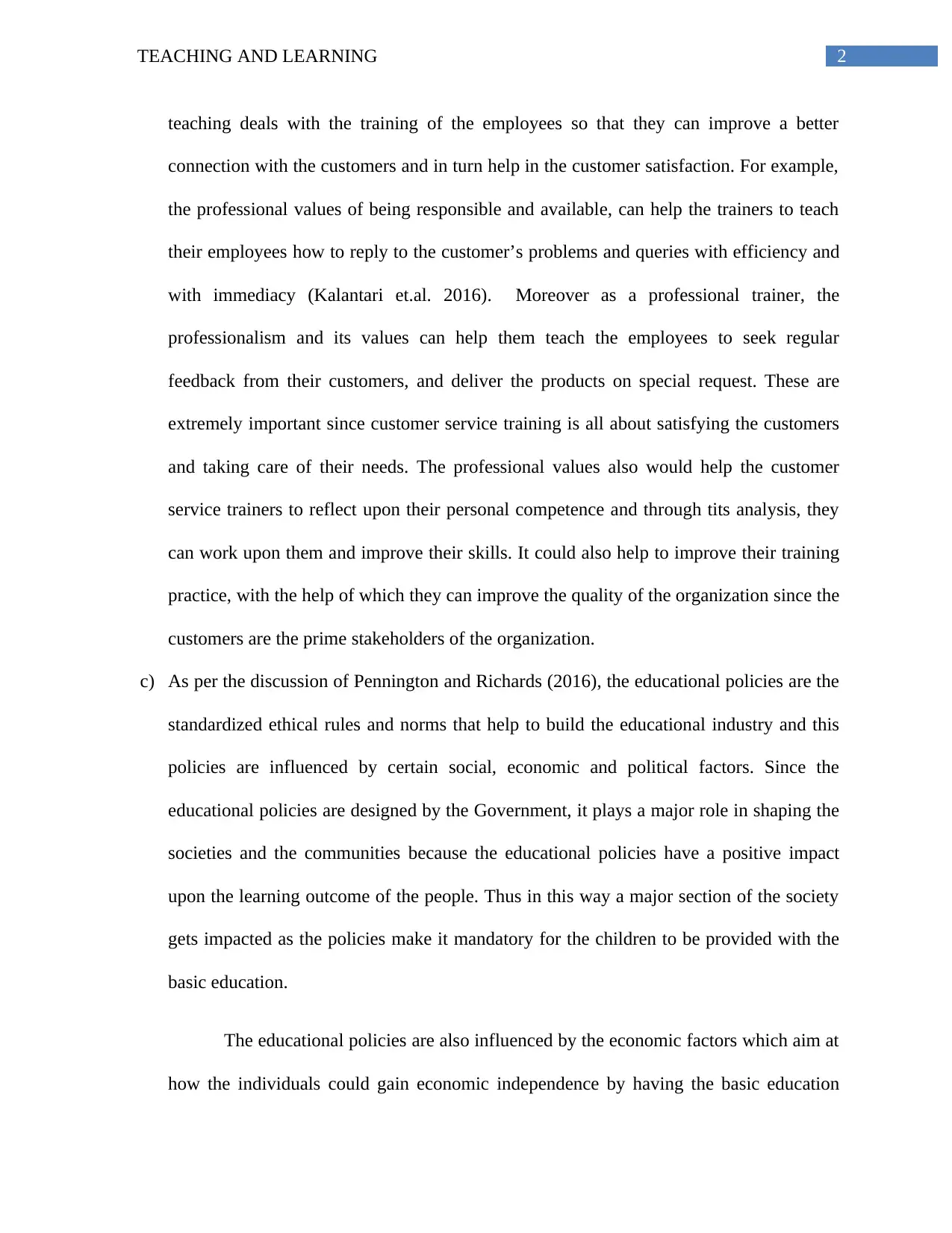
2TEACHING AND LEARNING
teaching deals with the training of the employees so that they can improve a better
connection with the customers and in turn help in the customer satisfaction. For example,
the professional values of being responsible and available, can help the trainers to teach
their employees how to reply to the customer’s problems and queries with efficiency and
with immediacy (Kalantari et.al. 2016). Moreover as a professional trainer, the
professionalism and its values can help them teach the employees to seek regular
feedback from their customers, and deliver the products on special request. These are
extremely important since customer service training is all about satisfying the customers
and taking care of their needs. The professional values also would help the customer
service trainers to reflect upon their personal competence and through tits analysis, they
can work upon them and improve their skills. It could also help to improve their training
practice, with the help of which they can improve the quality of the organization since the
customers are the prime stakeholders of the organization.
c) As per the discussion of Pennington and Richards (2016), the educational policies are the
standardized ethical rules and norms that help to build the educational industry and this
policies are influenced by certain social, economic and political factors. Since the
educational policies are designed by the Government, it plays a major role in shaping the
societies and the communities because the educational policies have a positive impact
upon the learning outcome of the people. Thus in this way a major section of the society
gets impacted as the policies make it mandatory for the children to be provided with the
basic education.
The educational policies are also influenced by the economic factors which aim at
how the individuals could gain economic independence by having the basic education
teaching deals with the training of the employees so that they can improve a better
connection with the customers and in turn help in the customer satisfaction. For example,
the professional values of being responsible and available, can help the trainers to teach
their employees how to reply to the customer’s problems and queries with efficiency and
with immediacy (Kalantari et.al. 2016). Moreover as a professional trainer, the
professionalism and its values can help them teach the employees to seek regular
feedback from their customers, and deliver the products on special request. These are
extremely important since customer service training is all about satisfying the customers
and taking care of their needs. The professional values also would help the customer
service trainers to reflect upon their personal competence and through tits analysis, they
can work upon them and improve their skills. It could also help to improve their training
practice, with the help of which they can improve the quality of the organization since the
customers are the prime stakeholders of the organization.
c) As per the discussion of Pennington and Richards (2016), the educational policies are the
standardized ethical rules and norms that help to build the educational industry and this
policies are influenced by certain social, economic and political factors. Since the
educational policies are designed by the Government, it plays a major role in shaping the
societies and the communities because the educational policies have a positive impact
upon the learning outcome of the people. Thus in this way a major section of the society
gets impacted as the policies make it mandatory for the children to be provided with the
basic education.
The educational policies are also influenced by the economic factors which aim at
how the individuals could gain economic independence by having the basic education
⊘ This is a preview!⊘
Do you want full access?
Subscribe today to unlock all pages.

Trusted by 1+ million students worldwide
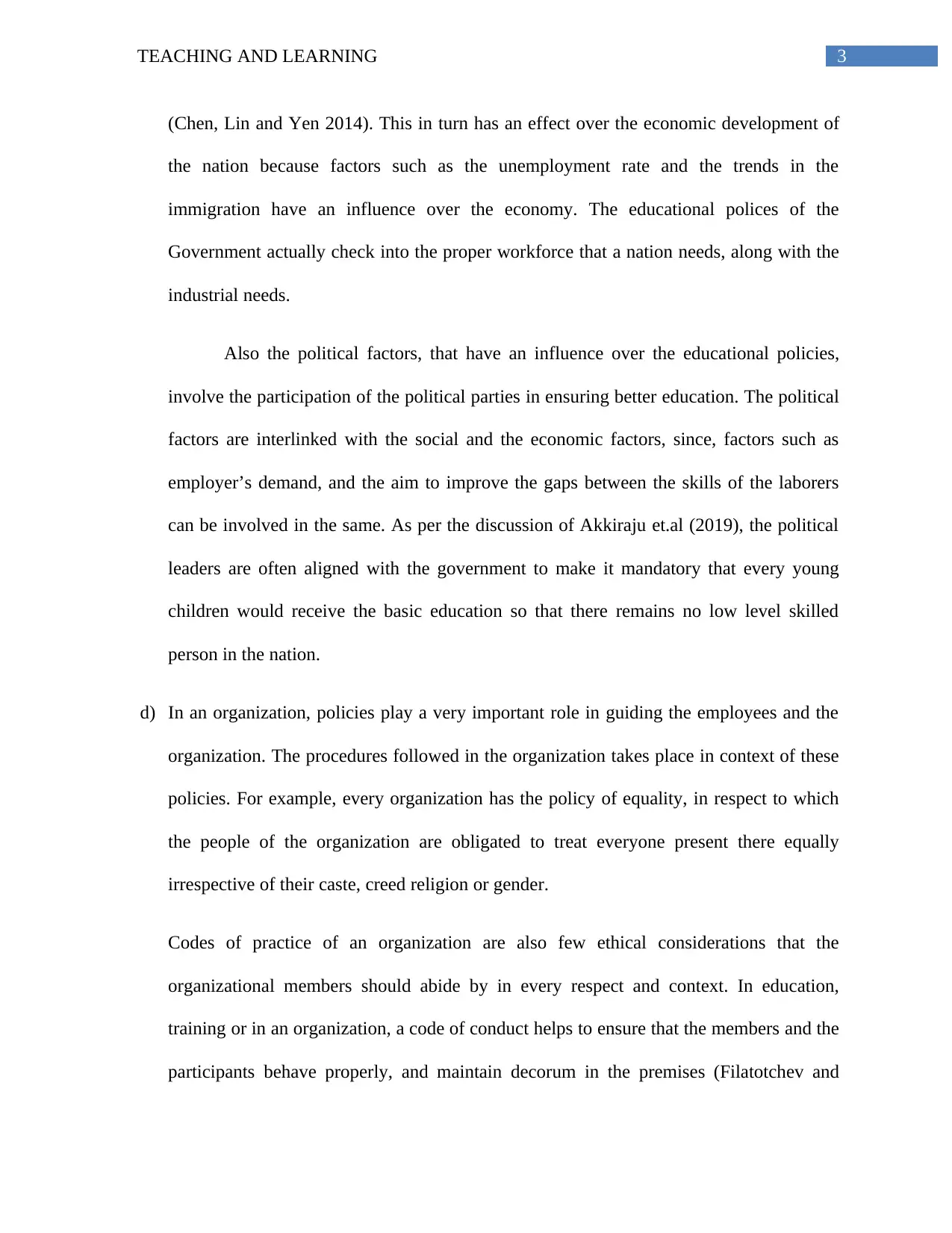
3TEACHING AND LEARNING
(Chen, Lin and Yen 2014). This in turn has an effect over the economic development of
the nation because factors such as the unemployment rate and the trends in the
immigration have an influence over the economy. The educational polices of the
Government actually check into the proper workforce that a nation needs, along with the
industrial needs.
Also the political factors, that have an influence over the educational policies,
involve the participation of the political parties in ensuring better education. The political
factors are interlinked with the social and the economic factors, since, factors such as
employer’s demand, and the aim to improve the gaps between the skills of the laborers
can be involved in the same. As per the discussion of Akkiraju et.al (2019), the political
leaders are often aligned with the government to make it mandatory that every young
children would receive the basic education so that there remains no low level skilled
person in the nation.
d) In an organization, policies play a very important role in guiding the employees and the
organization. The procedures followed in the organization takes place in context of these
policies. For example, every organization has the policy of equality, in respect to which
the people of the organization are obligated to treat everyone present there equally
irrespective of their caste, creed religion or gender.
Codes of practice of an organization are also few ethical considerations that the
organizational members should abide by in every respect and context. In education,
training or in an organization, a code of conduct helps to ensure that the members and the
participants behave properly, and maintain decorum in the premises (Filatotchev and
(Chen, Lin and Yen 2014). This in turn has an effect over the economic development of
the nation because factors such as the unemployment rate and the trends in the
immigration have an influence over the economy. The educational polices of the
Government actually check into the proper workforce that a nation needs, along with the
industrial needs.
Also the political factors, that have an influence over the educational policies,
involve the participation of the political parties in ensuring better education. The political
factors are interlinked with the social and the economic factors, since, factors such as
employer’s demand, and the aim to improve the gaps between the skills of the laborers
can be involved in the same. As per the discussion of Akkiraju et.al (2019), the political
leaders are often aligned with the government to make it mandatory that every young
children would receive the basic education so that there remains no low level skilled
person in the nation.
d) In an organization, policies play a very important role in guiding the employees and the
organization. The procedures followed in the organization takes place in context of these
policies. For example, every organization has the policy of equality, in respect to which
the people of the organization are obligated to treat everyone present there equally
irrespective of their caste, creed religion or gender.
Codes of practice of an organization are also few ethical considerations that the
organizational members should abide by in every respect and context. In education,
training or in an organization, a code of conduct helps to ensure that the members and the
participants behave properly, and maintain decorum in the premises (Filatotchev and
Paraphrase This Document
Need a fresh take? Get an instant paraphrase of this document with our AI Paraphraser
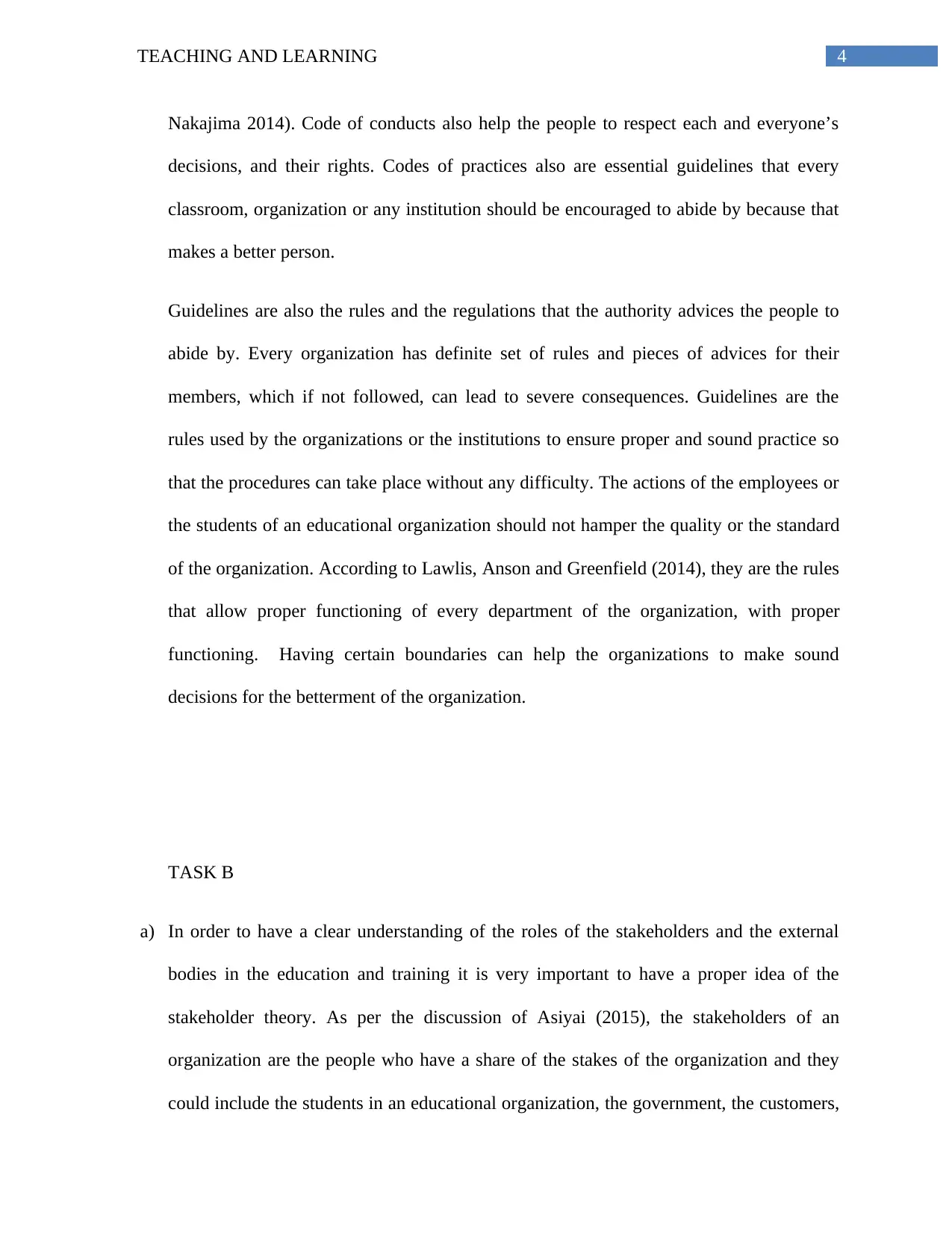
4TEACHING AND LEARNING
Nakajima 2014). Code of conducts also help the people to respect each and everyone’s
decisions, and their rights. Codes of practices also are essential guidelines that every
classroom, organization or any institution should be encouraged to abide by because that
makes a better person.
Guidelines are also the rules and the regulations that the authority advices the people to
abide by. Every organization has definite set of rules and pieces of advices for their
members, which if not followed, can lead to severe consequences. Guidelines are the
rules used by the organizations or the institutions to ensure proper and sound practice so
that the procedures can take place without any difficulty. The actions of the employees or
the students of an educational organization should not hamper the quality or the standard
of the organization. According to Lawlis, Anson and Greenfield (2014), they are the rules
that allow proper functioning of every department of the organization, with proper
functioning. Having certain boundaries can help the organizations to make sound
decisions for the betterment of the organization.
TASK B
a) In order to have a clear understanding of the roles of the stakeholders and the external
bodies in the education and training it is very important to have a proper idea of the
stakeholder theory. As per the discussion of Asiyai (2015), the stakeholders of an
organization are the people who have a share of the stakes of the organization and they
could include the students in an educational organization, the government, the customers,
Nakajima 2014). Code of conducts also help the people to respect each and everyone’s
decisions, and their rights. Codes of practices also are essential guidelines that every
classroom, organization or any institution should be encouraged to abide by because that
makes a better person.
Guidelines are also the rules and the regulations that the authority advices the people to
abide by. Every organization has definite set of rules and pieces of advices for their
members, which if not followed, can lead to severe consequences. Guidelines are the
rules used by the organizations or the institutions to ensure proper and sound practice so
that the procedures can take place without any difficulty. The actions of the employees or
the students of an educational organization should not hamper the quality or the standard
of the organization. According to Lawlis, Anson and Greenfield (2014), they are the rules
that allow proper functioning of every department of the organization, with proper
functioning. Having certain boundaries can help the organizations to make sound
decisions for the betterment of the organization.
TASK B
a) In order to have a clear understanding of the roles of the stakeholders and the external
bodies in the education and training it is very important to have a proper idea of the
stakeholder theory. As per the discussion of Asiyai (2015), the stakeholders of an
organization are the people who have a share of the stakes of the organization and they
could include the students in an educational organization, the government, the customers,
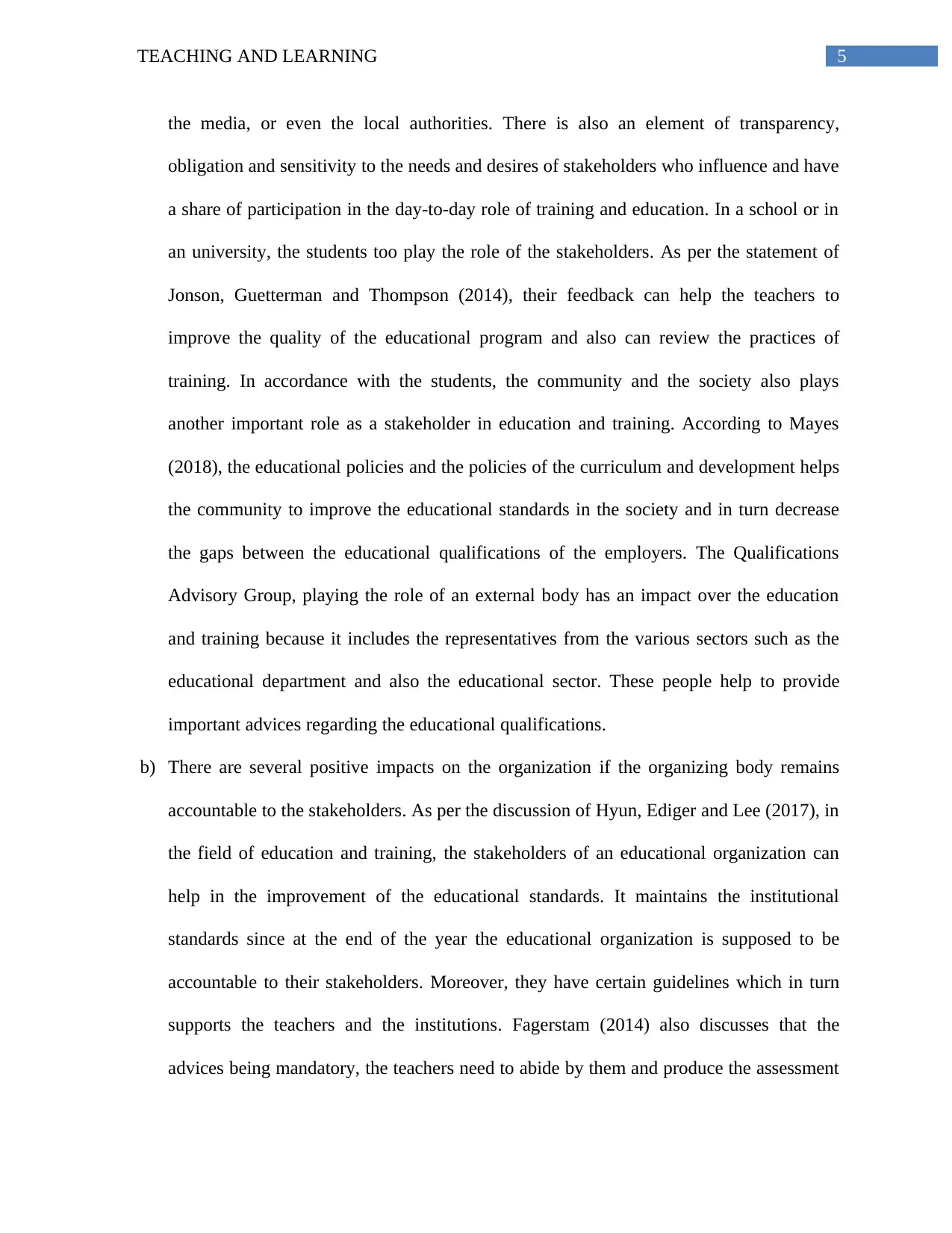
5TEACHING AND LEARNING
the media, or even the local authorities. There is also an element of transparency,
obligation and sensitivity to the needs and desires of stakeholders who influence and have
a share of participation in the day-to-day role of training and education. In a school or in
an university, the students too play the role of the stakeholders. As per the statement of
Jonson, Guetterman and Thompson (2014), their feedback can help the teachers to
improve the quality of the educational program and also can review the practices of
training. In accordance with the students, the community and the society also plays
another important role as a stakeholder in education and training. According to Mayes
(2018), the educational policies and the policies of the curriculum and development helps
the community to improve the educational standards in the society and in turn decrease
the gaps between the educational qualifications of the employers. The Qualifications
Advisory Group, playing the role of an external body has an impact over the education
and training because it includes the representatives from the various sectors such as the
educational department and also the educational sector. These people help to provide
important advices regarding the educational qualifications.
b) There are several positive impacts on the organization if the organizing body remains
accountable to the stakeholders. As per the discussion of Hyun, Ediger and Lee (2017), in
the field of education and training, the stakeholders of an educational organization can
help in the improvement of the educational standards. It maintains the institutional
standards since at the end of the year the educational organization is supposed to be
accountable to their stakeholders. Moreover, they have certain guidelines which in turn
supports the teachers and the institutions. Fagerstam (2014) also discusses that the
advices being mandatory, the teachers need to abide by them and produce the assessment
the media, or even the local authorities. There is also an element of transparency,
obligation and sensitivity to the needs and desires of stakeholders who influence and have
a share of participation in the day-to-day role of training and education. In a school or in
an university, the students too play the role of the stakeholders. As per the statement of
Jonson, Guetterman and Thompson (2014), their feedback can help the teachers to
improve the quality of the educational program and also can review the practices of
training. In accordance with the students, the community and the society also plays
another important role as a stakeholder in education and training. According to Mayes
(2018), the educational policies and the policies of the curriculum and development helps
the community to improve the educational standards in the society and in turn decrease
the gaps between the educational qualifications of the employers. The Qualifications
Advisory Group, playing the role of an external body has an impact over the education
and training because it includes the representatives from the various sectors such as the
educational department and also the educational sector. These people help to provide
important advices regarding the educational qualifications.
b) There are several positive impacts on the organization if the organizing body remains
accountable to the stakeholders. As per the discussion of Hyun, Ediger and Lee (2017), in
the field of education and training, the stakeholders of an educational organization can
help in the improvement of the educational standards. It maintains the institutional
standards since at the end of the year the educational organization is supposed to be
accountable to their stakeholders. Moreover, they have certain guidelines which in turn
supports the teachers and the institutions. Fagerstam (2014) also discusses that the
advices being mandatory, the teachers need to abide by them and produce the assessment
⊘ This is a preview!⊘
Do you want full access?
Subscribe today to unlock all pages.

Trusted by 1+ million students worldwide
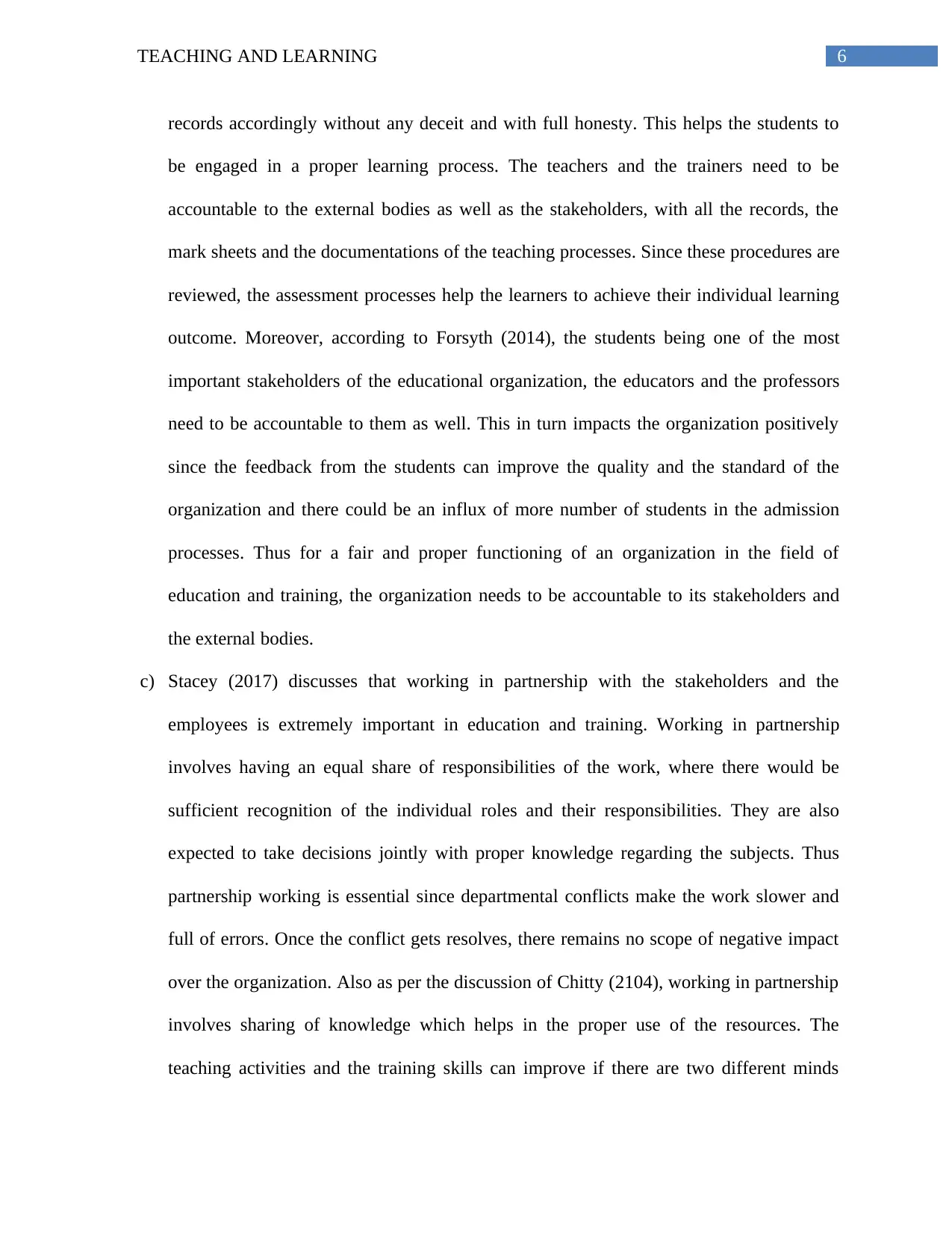
6TEACHING AND LEARNING
records accordingly without any deceit and with full honesty. This helps the students to
be engaged in a proper learning process. The teachers and the trainers need to be
accountable to the external bodies as well as the stakeholders, with all the records, the
mark sheets and the documentations of the teaching processes. Since these procedures are
reviewed, the assessment processes help the learners to achieve their individual learning
outcome. Moreover, according to Forsyth (2014), the students being one of the most
important stakeholders of the educational organization, the educators and the professors
need to be accountable to them as well. This in turn impacts the organization positively
since the feedback from the students can improve the quality and the standard of the
organization and there could be an influx of more number of students in the admission
processes. Thus for a fair and proper functioning of an organization in the field of
education and training, the organization needs to be accountable to its stakeholders and
the external bodies.
c) Stacey (2017) discusses that working in partnership with the stakeholders and the
employees is extremely important in education and training. Working in partnership
involves having an equal share of responsibilities of the work, where there would be
sufficient recognition of the individual roles and their responsibilities. They are also
expected to take decisions jointly with proper knowledge regarding the subjects. Thus
partnership working is essential since departmental conflicts make the work slower and
full of errors. Once the conflict gets resolves, there remains no scope of negative impact
over the organization. Also as per the discussion of Chitty (2104), working in partnership
involves sharing of knowledge which helps in the proper use of the resources. The
teaching activities and the training skills can improve if there are two different minds
records accordingly without any deceit and with full honesty. This helps the students to
be engaged in a proper learning process. The teachers and the trainers need to be
accountable to the external bodies as well as the stakeholders, with all the records, the
mark sheets and the documentations of the teaching processes. Since these procedures are
reviewed, the assessment processes help the learners to achieve their individual learning
outcome. Moreover, according to Forsyth (2014), the students being one of the most
important stakeholders of the educational organization, the educators and the professors
need to be accountable to them as well. This in turn impacts the organization positively
since the feedback from the students can improve the quality and the standard of the
organization and there could be an influx of more number of students in the admission
processes. Thus for a fair and proper functioning of an organization in the field of
education and training, the organization needs to be accountable to its stakeholders and
the external bodies.
c) Stacey (2017) discusses that working in partnership with the stakeholders and the
employees is extremely important in education and training. Working in partnership
involves having an equal share of responsibilities of the work, where there would be
sufficient recognition of the individual roles and their responsibilities. They are also
expected to take decisions jointly with proper knowledge regarding the subjects. Thus
partnership working is essential since departmental conflicts make the work slower and
full of errors. Once the conflict gets resolves, there remains no scope of negative impact
over the organization. Also as per the discussion of Chitty (2104), working in partnership
involves sharing of knowledge which helps in the proper use of the resources. The
teaching activities and the training skills can improve if there are two different minds
Paraphrase This Document
Need a fresh take? Get an instant paraphrase of this document with our AI Paraphraser
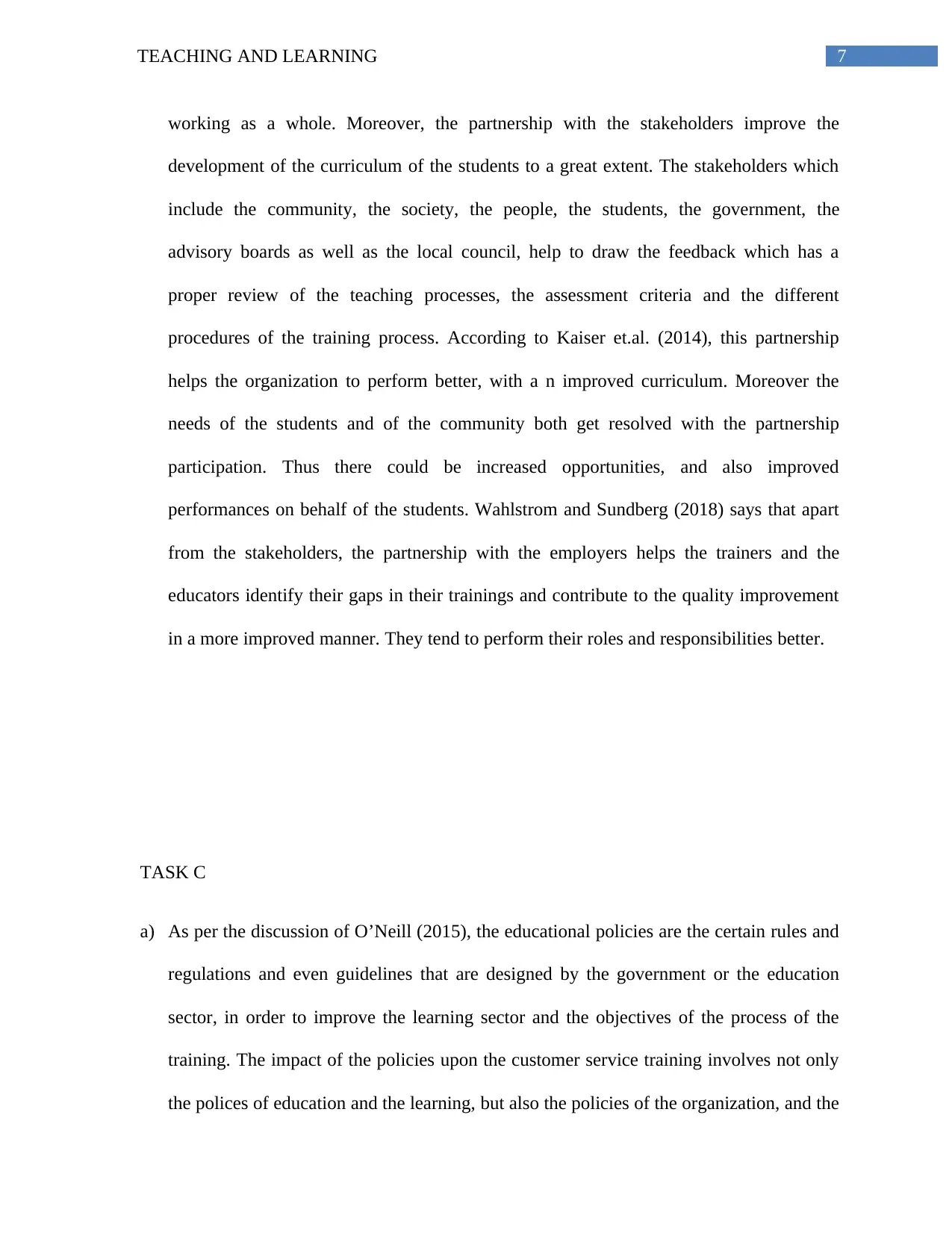
7TEACHING AND LEARNING
working as a whole. Moreover, the partnership with the stakeholders improve the
development of the curriculum of the students to a great extent. The stakeholders which
include the community, the society, the people, the students, the government, the
advisory boards as well as the local council, help to draw the feedback which has a
proper review of the teaching processes, the assessment criteria and the different
procedures of the training process. According to Kaiser et.al. (2014), this partnership
helps the organization to perform better, with a n improved curriculum. Moreover the
needs of the students and of the community both get resolved with the partnership
participation. Thus there could be increased opportunities, and also improved
performances on behalf of the students. Wahlstrom and Sundberg (2018) says that apart
from the stakeholders, the partnership with the employers helps the trainers and the
educators identify their gaps in their trainings and contribute to the quality improvement
in a more improved manner. They tend to perform their roles and responsibilities better.
TASK C
a) As per the discussion of O’Neill (2015), the educational policies are the certain rules and
regulations and even guidelines that are designed by the government or the education
sector, in order to improve the learning sector and the objectives of the process of the
training. The impact of the policies upon the customer service training involves not only
the polices of education and the learning, but also the policies of the organization, and the
working as a whole. Moreover, the partnership with the stakeholders improve the
development of the curriculum of the students to a great extent. The stakeholders which
include the community, the society, the people, the students, the government, the
advisory boards as well as the local council, help to draw the feedback which has a
proper review of the teaching processes, the assessment criteria and the different
procedures of the training process. According to Kaiser et.al. (2014), this partnership
helps the organization to perform better, with a n improved curriculum. Moreover the
needs of the students and of the community both get resolved with the partnership
participation. Thus there could be increased opportunities, and also improved
performances on behalf of the students. Wahlstrom and Sundberg (2018) says that apart
from the stakeholders, the partnership with the employers helps the trainers and the
educators identify their gaps in their trainings and contribute to the quality improvement
in a more improved manner. They tend to perform their roles and responsibilities better.
TASK C
a) As per the discussion of O’Neill (2015), the educational policies are the certain rules and
regulations and even guidelines that are designed by the government or the education
sector, in order to improve the learning sector and the objectives of the process of the
training. The impact of the policies upon the customer service training involves not only
the polices of education and the learning, but also the policies of the organization, and the
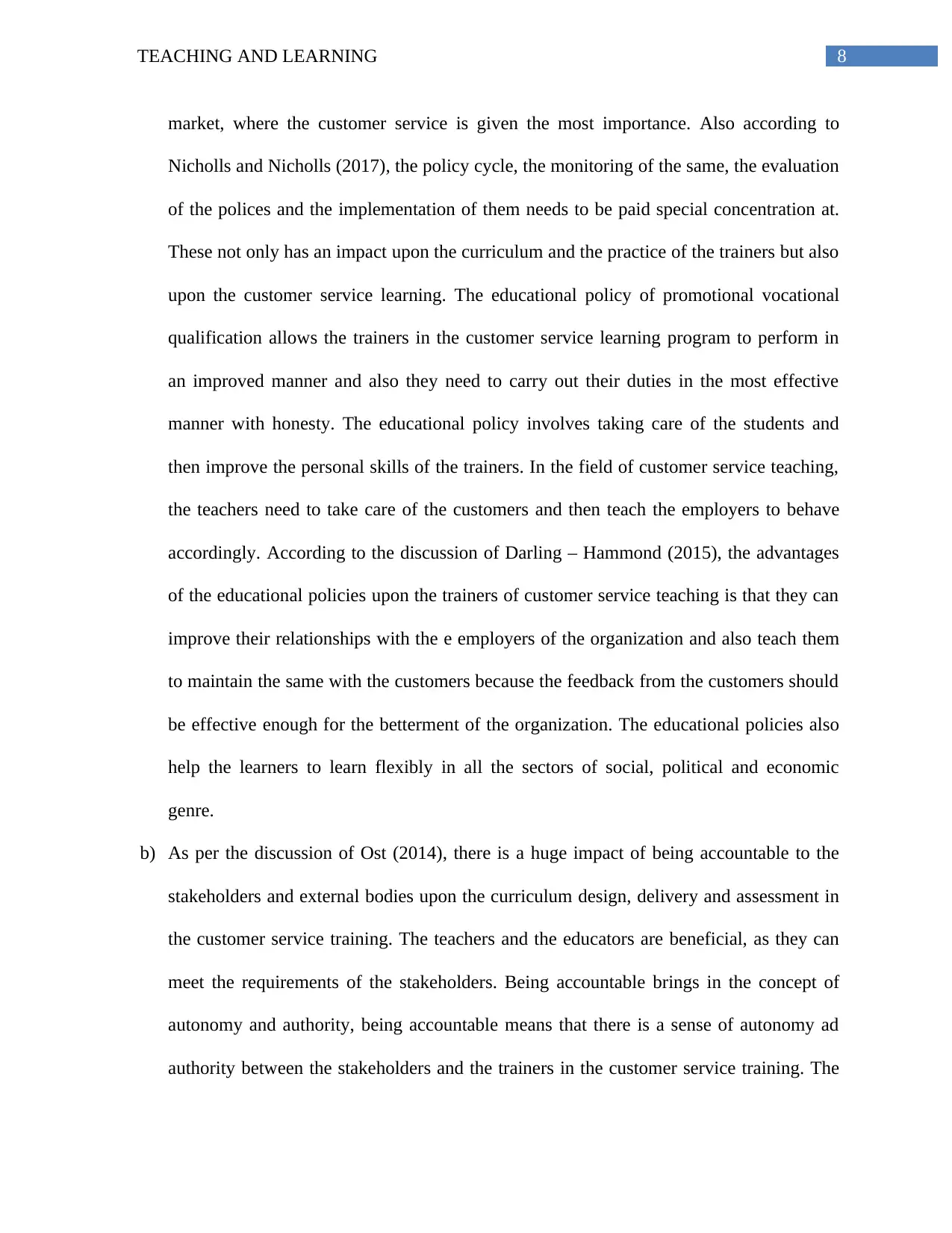
8TEACHING AND LEARNING
market, where the customer service is given the most importance. Also according to
Nicholls and Nicholls (2017), the policy cycle, the monitoring of the same, the evaluation
of the polices and the implementation of them needs to be paid special concentration at.
These not only has an impact upon the curriculum and the practice of the trainers but also
upon the customer service learning. The educational policy of promotional vocational
qualification allows the trainers in the customer service learning program to perform in
an improved manner and also they need to carry out their duties in the most effective
manner with honesty. The educational policy involves taking care of the students and
then improve the personal skills of the trainers. In the field of customer service teaching,
the teachers need to take care of the customers and then teach the employers to behave
accordingly. According to the discussion of Darling – Hammond (2015), the advantages
of the educational policies upon the trainers of customer service teaching is that they can
improve their relationships with the e employers of the organization and also teach them
to maintain the same with the customers because the feedback from the customers should
be effective enough for the betterment of the organization. The educational policies also
help the learners to learn flexibly in all the sectors of social, political and economic
genre.
b) As per the discussion of Ost (2014), there is a huge impact of being accountable to the
stakeholders and external bodies upon the curriculum design, delivery and assessment in
the customer service training. The teachers and the educators are beneficial, as they can
meet the requirements of the stakeholders. Being accountable brings in the concept of
autonomy and authority, being accountable means that there is a sense of autonomy ad
authority between the stakeholders and the trainers in the customer service training. The
market, where the customer service is given the most importance. Also according to
Nicholls and Nicholls (2017), the policy cycle, the monitoring of the same, the evaluation
of the polices and the implementation of them needs to be paid special concentration at.
These not only has an impact upon the curriculum and the practice of the trainers but also
upon the customer service learning. The educational policy of promotional vocational
qualification allows the trainers in the customer service learning program to perform in
an improved manner and also they need to carry out their duties in the most effective
manner with honesty. The educational policy involves taking care of the students and
then improve the personal skills of the trainers. In the field of customer service teaching,
the teachers need to take care of the customers and then teach the employers to behave
accordingly. According to the discussion of Darling – Hammond (2015), the advantages
of the educational policies upon the trainers of customer service teaching is that they can
improve their relationships with the e employers of the organization and also teach them
to maintain the same with the customers because the feedback from the customers should
be effective enough for the betterment of the organization. The educational policies also
help the learners to learn flexibly in all the sectors of social, political and economic
genre.
b) As per the discussion of Ost (2014), there is a huge impact of being accountable to the
stakeholders and external bodies upon the curriculum design, delivery and assessment in
the customer service training. The teachers and the educators are beneficial, as they can
meet the requirements of the stakeholders. Being accountable brings in the concept of
autonomy and authority, being accountable means that there is a sense of autonomy ad
authority between the stakeholders and the trainers in the customer service training. The
⊘ This is a preview!⊘
Do you want full access?
Subscribe today to unlock all pages.

Trusted by 1+ million students worldwide
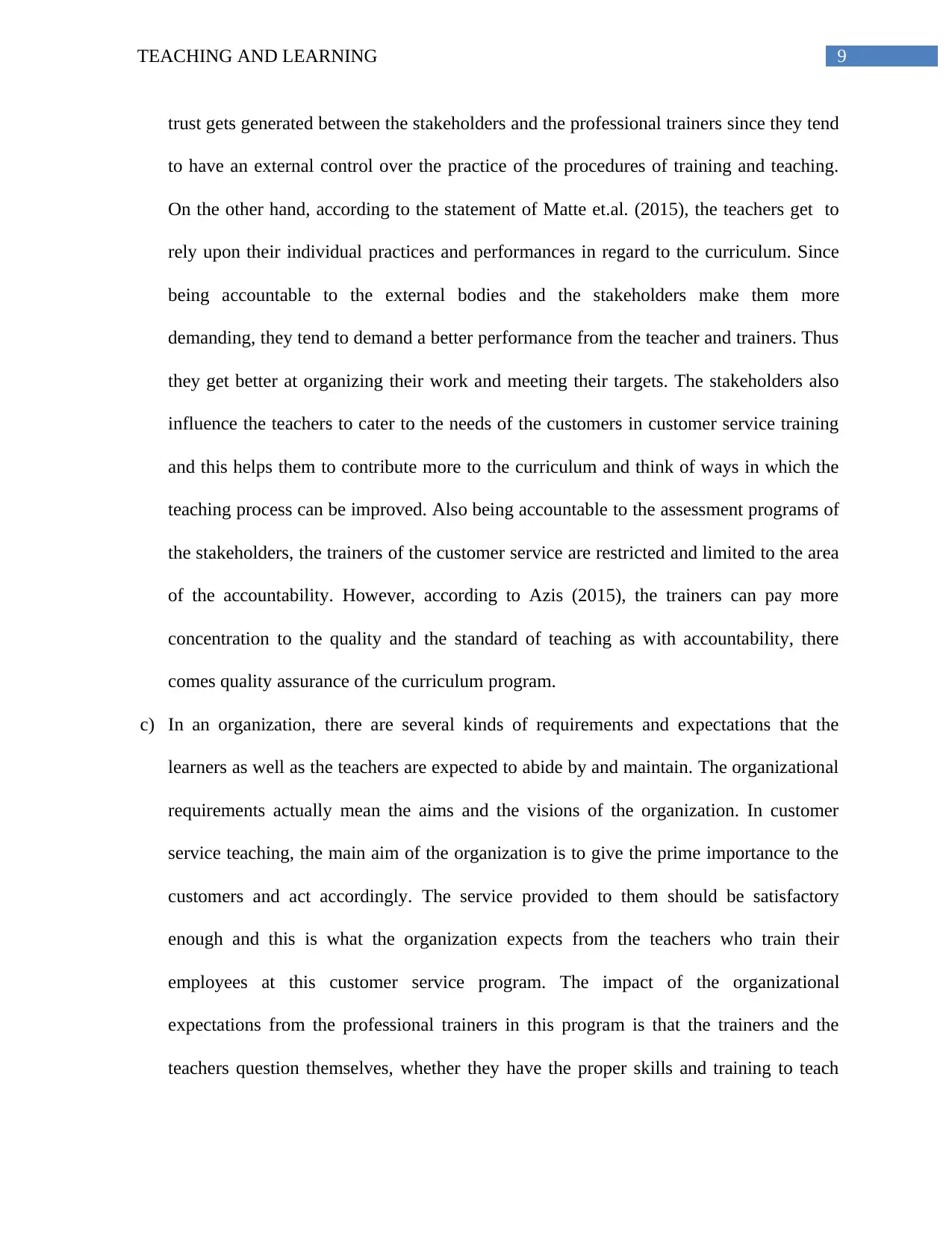
9TEACHING AND LEARNING
trust gets generated between the stakeholders and the professional trainers since they tend
to have an external control over the practice of the procedures of training and teaching.
On the other hand, according to the statement of Matte et.al. (2015), the teachers get to
rely upon their individual practices and performances in regard to the curriculum. Since
being accountable to the external bodies and the stakeholders make them more
demanding, they tend to demand a better performance from the teacher and trainers. Thus
they get better at organizing their work and meeting their targets. The stakeholders also
influence the teachers to cater to the needs of the customers in customer service training
and this helps them to contribute more to the curriculum and think of ways in which the
teaching process can be improved. Also being accountable to the assessment programs of
the stakeholders, the trainers of the customer service are restricted and limited to the area
of the accountability. However, according to Azis (2015), the trainers can pay more
concentration to the quality and the standard of teaching as with accountability, there
comes quality assurance of the curriculum program.
c) In an organization, there are several kinds of requirements and expectations that the
learners as well as the teachers are expected to abide by and maintain. The organizational
requirements actually mean the aims and the visions of the organization. In customer
service teaching, the main aim of the organization is to give the prime importance to the
customers and act accordingly. The service provided to them should be satisfactory
enough and this is what the organization expects from the teachers who train their
employees at this customer service program. The impact of the organizational
expectations from the professional trainers in this program is that the trainers and the
teachers question themselves, whether they have the proper skills and training to teach
trust gets generated between the stakeholders and the professional trainers since they tend
to have an external control over the practice of the procedures of training and teaching.
On the other hand, according to the statement of Matte et.al. (2015), the teachers get to
rely upon their individual practices and performances in regard to the curriculum. Since
being accountable to the external bodies and the stakeholders make them more
demanding, they tend to demand a better performance from the teacher and trainers. Thus
they get better at organizing their work and meeting their targets. The stakeholders also
influence the teachers to cater to the needs of the customers in customer service training
and this helps them to contribute more to the curriculum and think of ways in which the
teaching process can be improved. Also being accountable to the assessment programs of
the stakeholders, the trainers of the customer service are restricted and limited to the area
of the accountability. However, according to Azis (2015), the trainers can pay more
concentration to the quality and the standard of teaching as with accountability, there
comes quality assurance of the curriculum program.
c) In an organization, there are several kinds of requirements and expectations that the
learners as well as the teachers are expected to abide by and maintain. The organizational
requirements actually mean the aims and the visions of the organization. In customer
service teaching, the main aim of the organization is to give the prime importance to the
customers and act accordingly. The service provided to them should be satisfactory
enough and this is what the organization expects from the teachers who train their
employees at this customer service program. The impact of the organizational
expectations from the professional trainers in this program is that the trainers and the
teachers question themselves, whether they have the proper skills and training to teach
Paraphrase This Document
Need a fresh take? Get an instant paraphrase of this document with our AI Paraphraser
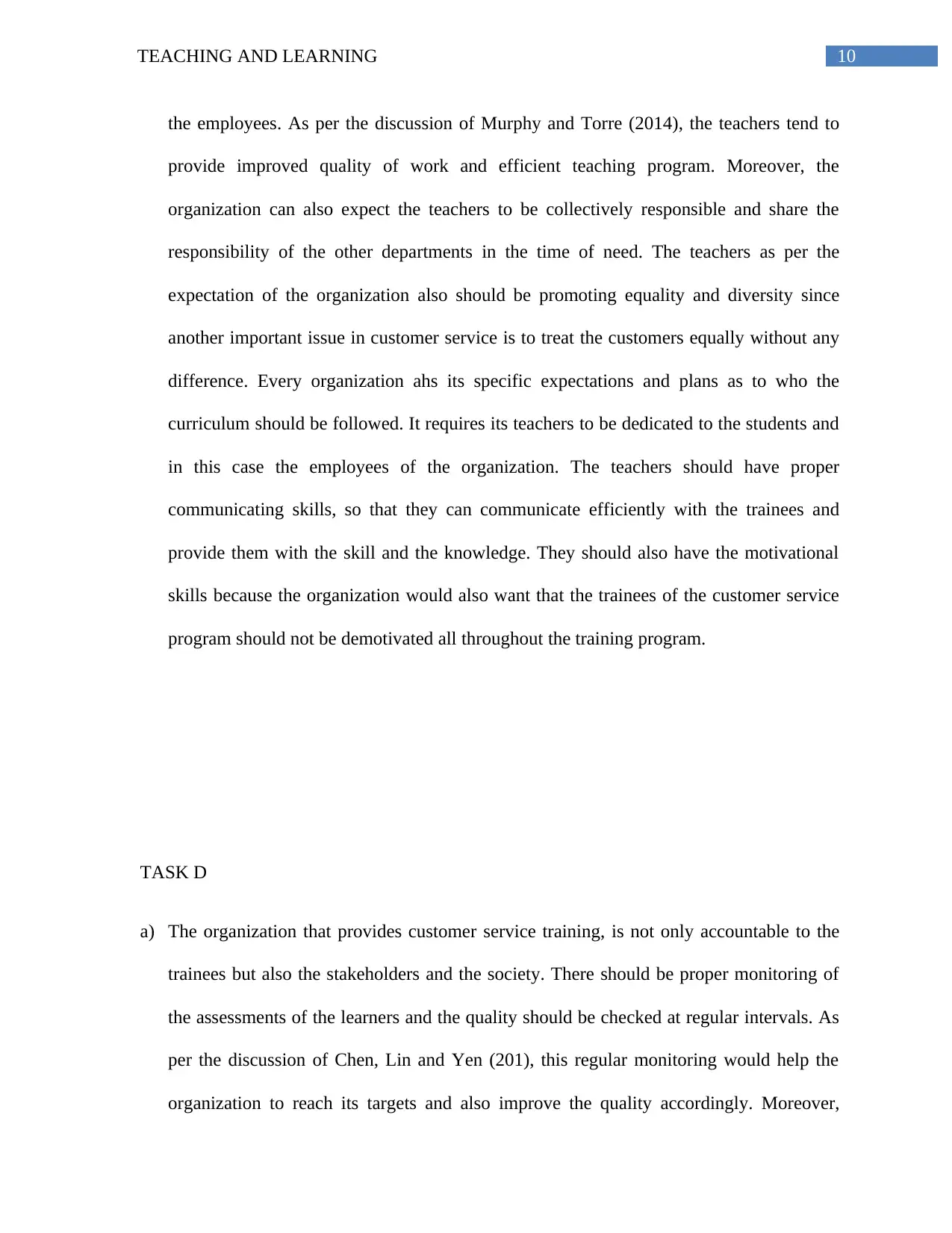
10TEACHING AND LEARNING
the employees. As per the discussion of Murphy and Torre (2014), the teachers tend to
provide improved quality of work and efficient teaching program. Moreover, the
organization can also expect the teachers to be collectively responsible and share the
responsibility of the other departments in the time of need. The teachers as per the
expectation of the organization also should be promoting equality and diversity since
another important issue in customer service is to treat the customers equally without any
difference. Every organization ahs its specific expectations and plans as to who the
curriculum should be followed. It requires its teachers to be dedicated to the students and
in this case the employees of the organization. The teachers should have proper
communicating skills, so that they can communicate efficiently with the trainees and
provide them with the skill and the knowledge. They should also have the motivational
skills because the organization would also want that the trainees of the customer service
program should not be demotivated all throughout the training program.
TASK D
a) The organization that provides customer service training, is not only accountable to the
trainees but also the stakeholders and the society. There should be proper monitoring of
the assessments of the learners and the quality should be checked at regular intervals. As
per the discussion of Chen, Lin and Yen (201), this regular monitoring would help the
organization to reach its targets and also improve the quality accordingly. Moreover,
the employees. As per the discussion of Murphy and Torre (2014), the teachers tend to
provide improved quality of work and efficient teaching program. Moreover, the
organization can also expect the teachers to be collectively responsible and share the
responsibility of the other departments in the time of need. The teachers as per the
expectation of the organization also should be promoting equality and diversity since
another important issue in customer service is to treat the customers equally without any
difference. Every organization ahs its specific expectations and plans as to who the
curriculum should be followed. It requires its teachers to be dedicated to the students and
in this case the employees of the organization. The teachers should have proper
communicating skills, so that they can communicate efficiently with the trainees and
provide them with the skill and the knowledge. They should also have the motivational
skills because the organization would also want that the trainees of the customer service
program should not be demotivated all throughout the training program.
TASK D
a) The organization that provides customer service training, is not only accountable to the
trainees but also the stakeholders and the society. There should be proper monitoring of
the assessments of the learners and the quality should be checked at regular intervals. As
per the discussion of Chen, Lin and Yen (201), this regular monitoring would help the
organization to reach its targets and also improve the quality accordingly. Moreover,
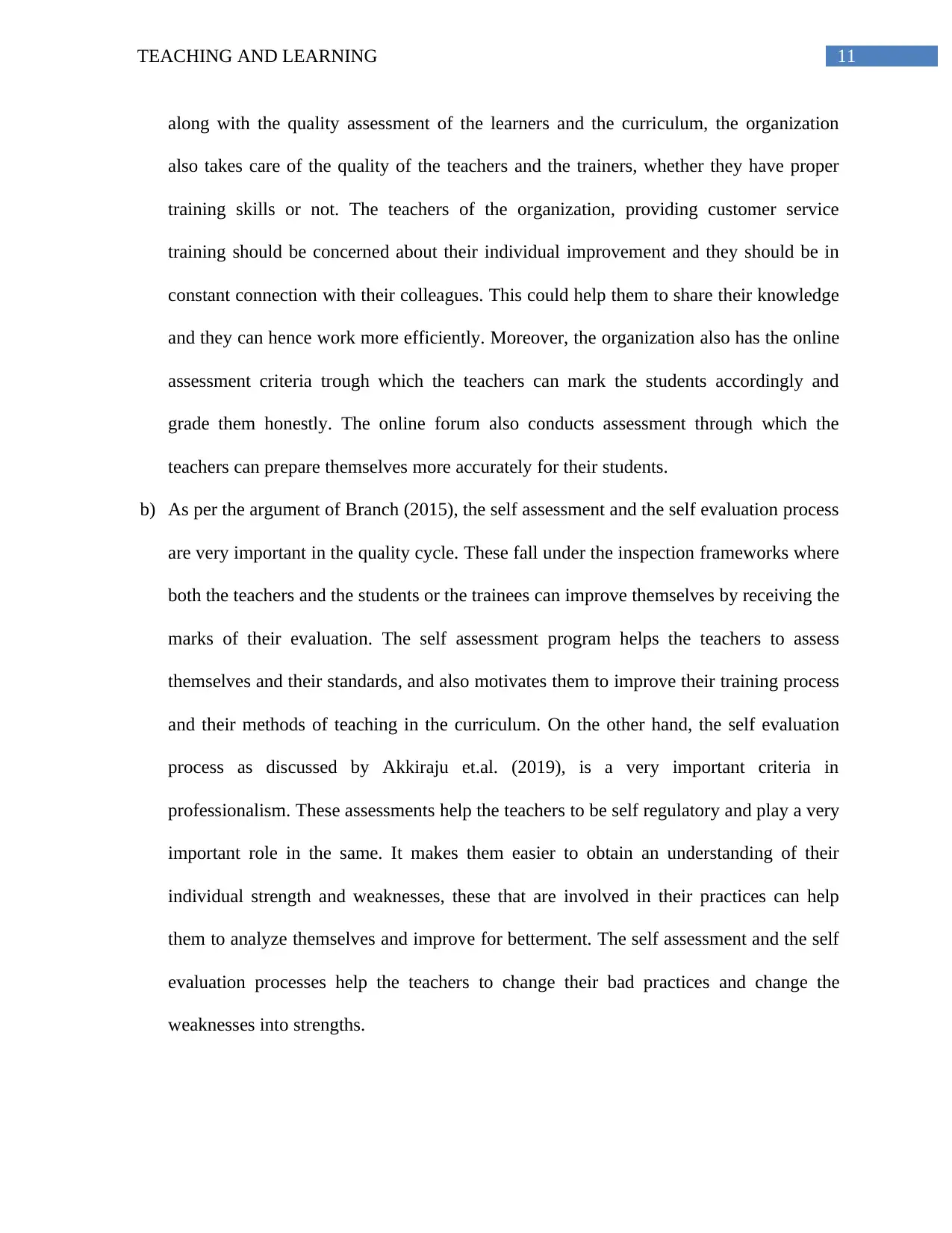
11TEACHING AND LEARNING
along with the quality assessment of the learners and the curriculum, the organization
also takes care of the quality of the teachers and the trainers, whether they have proper
training skills or not. The teachers of the organization, providing customer service
training should be concerned about their individual improvement and they should be in
constant connection with their colleagues. This could help them to share their knowledge
and they can hence work more efficiently. Moreover, the organization also has the online
assessment criteria trough which the teachers can mark the students accordingly and
grade them honestly. The online forum also conducts assessment through which the
teachers can prepare themselves more accurately for their students.
b) As per the argument of Branch (2015), the self assessment and the self evaluation process
are very important in the quality cycle. These fall under the inspection frameworks where
both the teachers and the students or the trainees can improve themselves by receiving the
marks of their evaluation. The self assessment program helps the teachers to assess
themselves and their standards, and also motivates them to improve their training process
and their methods of teaching in the curriculum. On the other hand, the self evaluation
process as discussed by Akkiraju et.al. (2019), is a very important criteria in
professionalism. These assessments help the teachers to be self regulatory and play a very
important role in the same. It makes them easier to obtain an understanding of their
individual strength and weaknesses, these that are involved in their practices can help
them to analyze themselves and improve for betterment. The self assessment and the self
evaluation processes help the teachers to change their bad practices and change the
weaknesses into strengths.
along with the quality assessment of the learners and the curriculum, the organization
also takes care of the quality of the teachers and the trainers, whether they have proper
training skills or not. The teachers of the organization, providing customer service
training should be concerned about their individual improvement and they should be in
constant connection with their colleagues. This could help them to share their knowledge
and they can hence work more efficiently. Moreover, the organization also has the online
assessment criteria trough which the teachers can mark the students accordingly and
grade them honestly. The online forum also conducts assessment through which the
teachers can prepare themselves more accurately for their students.
b) As per the argument of Branch (2015), the self assessment and the self evaluation process
are very important in the quality cycle. These fall under the inspection frameworks where
both the teachers and the students or the trainees can improve themselves by receiving the
marks of their evaluation. The self assessment program helps the teachers to assess
themselves and their standards, and also motivates them to improve their training process
and their methods of teaching in the curriculum. On the other hand, the self evaluation
process as discussed by Akkiraju et.al. (2019), is a very important criteria in
professionalism. These assessments help the teachers to be self regulatory and play a very
important role in the same. It makes them easier to obtain an understanding of their
individual strength and weaknesses, these that are involved in their practices can help
them to analyze themselves and improve for betterment. The self assessment and the self
evaluation processes help the teachers to change their bad practices and change the
weaknesses into strengths.
⊘ This is a preview!⊘
Do you want full access?
Subscribe today to unlock all pages.

Trusted by 1+ million students worldwide
1 out of 18
Related Documents
Your All-in-One AI-Powered Toolkit for Academic Success.
+13062052269
info@desklib.com
Available 24*7 on WhatsApp / Email
![[object Object]](/_next/static/media/star-bottom.7253800d.svg)
Unlock your academic potential
Copyright © 2020–2025 A2Z Services. All Rights Reserved. Developed and managed by ZUCOL.





